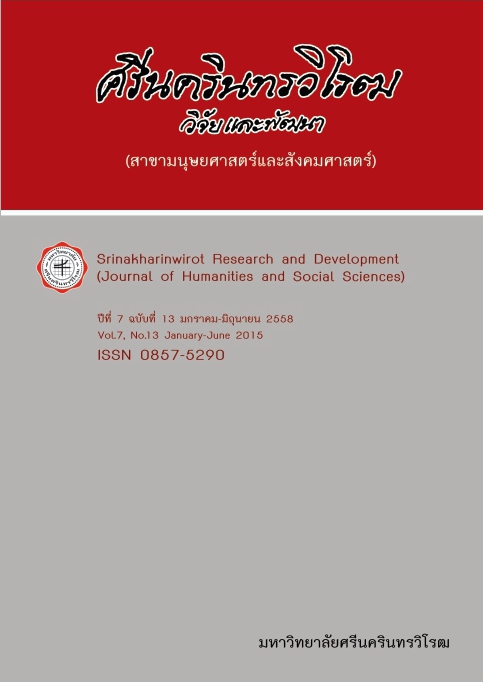โมเดลเชิงสาเหตุและผลของทักษะชีวิตของนักเรียนอาชีวศึกษา A CAUSE AND EFFECT MODEL OF LIFE SKILLS OF VOCATIONAL EDUCATION STUDENTS
Keywords:
ทักษะชีวิต โมเดลเชิงสาเหตุและผล นักเรียนอาชีวศึกษาAbstract
บทคัดย่อ
การวิจัยนี้มีวัตถุประสงค์คือ (1) เพื่อพัฒนาโมเดลเชิงสาเหตุและผลของทักษะชีวิตนักเรียนอาชีวศึกษา
(2) เพื่อตรวจสอบความสอดคล้องของโมเดลเชิงสาเหตุและผลของทักษะชีวิต ของนักเรียนอาชีวศึกษากับข้อมูลเชิงประจักษ์ กลุ่มตัวอย่างที่ใช้ จำนวน 840 คน คือ นักเรียนระดับประกาศนียบัตรวิชาชีพปีที่ 1 ปีที่ 2 และ ปีที่ 3 ปีการศึกษา 2555 ของโรงเรียนในสังกัดสำนักงานคณะกรรมการการอาชีวศึกษา ซึ่งเป็นโรงเรียนใน 7 ภูมิภาคของประเทศไทย ประกอบด้วย กรุงเทพมหานครและปริมณฑล ภาคเหนือ ภาคกลาง ภาคตะวันออกเฉียงเหนือ ภาคใต้ ภาคตะวันออก และภาคตะวันตก ตัวแปรที่ใช้ในการวิจัยในครั้งนี้ประกอบด้วยตัวแปรแฝง จำนวน 7 ตัวแปร คือ ทักษะชีวิต คุณภาพนักเรียน รูปแบบการเรียน แรงจูงใจใฝ่สัมฤทธิ์ เจตคติต่อตนเองและการเรียน พื้นฐานครอบครัว และสัมพันธภาพทางสังคม ซึ่งตัวแปรแฝงดังกล่าววัดจากตัวแปรสังเกตได้ จำนวน 22 ตัวแปร เครื่องมือที่ใช้ในการวิจัยครั้งนี้คือ แบบสอบถาม จำนวน 700 ชุด ที่มีค่าความเที่ยง .810 ถึง .952 วิเคราะห์ข้อมูลโดยใช้การวิเคราะห์ค่าสถิติพื้นฐาน การวิเคราะห์ค่าสัมประสิทธิ์สหสัมพันธ์แบบเพียร์สัน และการวิเคราะห์โมเดลริสเรล ผลการวิจัยสรุปได้ดังนี้
(1) โมเดลเชิงสาเหตุและผลของทักษะชีวิตของนักเรียนอาชีวศึกษาประกอบด้วยปัจจัยที่มีอิทธิพลทางตรงต่อทักษะชีวิตอย่างมีนัยสำคัญทางสถิติที่ระดับ 0.05 ตัวแปรที่มีขนาดอิทธิพลสูงสุด คือ สัมพันธภาพทางสังคม มีขนาดอิทธิพล 0.30 รองลงมา คือ เจตคติต่อตนเองและการเรียน มีขนาดอิทธิพล 0.24 พื้นฐานครอบครัว มีขนาดอิทธิพล 0.21 และรูปแบบการเรียน มีขนาดอิทธิพล 0.17 ทักษะชีวิตมีอิทธิพลทางตรงต่อคุณภาพนักเรียนอย่างมีนัยสำคัญทางสถิติที่ระดับ 0.05 โดยมีขนาดอิทธิพลเท่ากับ 0.94 (2) การวิเคราะห์ความสอดคล้องของโมเดลเชิงสาเหตุและผลของทักษะชีวิตของนักเรียนอาชีวศึกษา พบว่า โมเดลเชิงสาเหตุและผลของทักษะชีวิตของนักเรียนอาชีวศึกษาสอดคล้องกับข้อมูลเชิงประจักษ์ โดยมีค่า ไค-สแควร์ ( 2) เท่ากับ 12.63 องศาอิสระ เท่ากับ 7 ที่ระดับความน่าจะเป็น (P) เท่ากับ .082 ค่า GFI = .99 ค่า AGFI=.98 และค่า RMR = .00 ตัวแปรในโมเดลสามารถอธิบายความแปรปรวนของทักษะชีวิตของนักเรียนอาชีวศึกษา ได้ร้อยละ 59 และตัวแปรทักษะชีวิตสามารถอธิบายความแปรปรวนของคุณภาพนักเรียนอาชีวศึกษา ได้ร้อยละ 27
Abstract
The aims of this research were: (1) to develop a causal model and results of life skills of vocational education students; (2) to test model corresponds of the causal model and results of vocational education students’ life skills with empirical data. The applied samples amount 840 were first; second; and third year vocational students who were studied in academic year 2011 of schools under the Vocational Education Commission from seven regions of Thailand. They were included the Bangkok metropolitan region, northern region, central region, northeastern region, southern region, eastern region, and western region. The used variables of this research were composed of 7 latent variables - life skills, student quality, learning patterns, motive achievement, attitudes toward self and learning, family background, and social relationships. These latent variables were measured from 22 observed variables. The research tool was questionnaire amount 700 where reliability coefficient had ranged from .810 to .952. Data were analyzed by descriptive statistics, Pearson’s correlation coefficient, and LISREL.
The results were concluded as follows: (1) the causal model and results of life skills consisted of the direct factors affecting life skills which are the social relationship factors (0.3), attitude toward self and learning (0.24), family background (0.21), and learning patterns (0.17). The life skills directly affected student quality which had sized effecting 0.94, significant at 0.05 ; (2) the analysis results of the causal model and results of life skills were found that the model corresponded with empirical data where the chi-square ( 2) was 12.63, degrees of freedom (df) was 7, adjusted possibility (P) was .082. The GFI was. 99, adjusted goodness of fit index (AGFI) was .98, and the root mean residual (RMR) was .00. The variables in the model can explain variations of vocational education students' life skill as 59 per cent, and the life skill variables can explain variations of vocational student quality as 27 per cent.Downloads
Downloads
Published
How to Cite
Issue
Section
License
Srinakharinwirot Research and Development Journal of Humanities and Social Sciences is licensed Under a Creative Commons Attribution-NonCommercial-NoDerivs 4.0 International (CC-BY-NC-ND 4.0) License, Unless Otherwise Stated. Please Read Journal Policies Page for More Information on Open Access, Copyright and Permissions.



